Lindsey Halligan's humiliation continues apace
She's bad at media, and even worse at law.
Public Notice is supported by paid subscribers. Become one ⬇️
Monday was a rough one for Lindsey Halligan, who proved herself bad at media and law.
First she discovered — too late! — that you have to tell reporters beforehand if you want the conversation to be off the record.
From Halligan’s text exchange with Anna Bower of Lawfare (who, for the record, is a fantastic journalist):
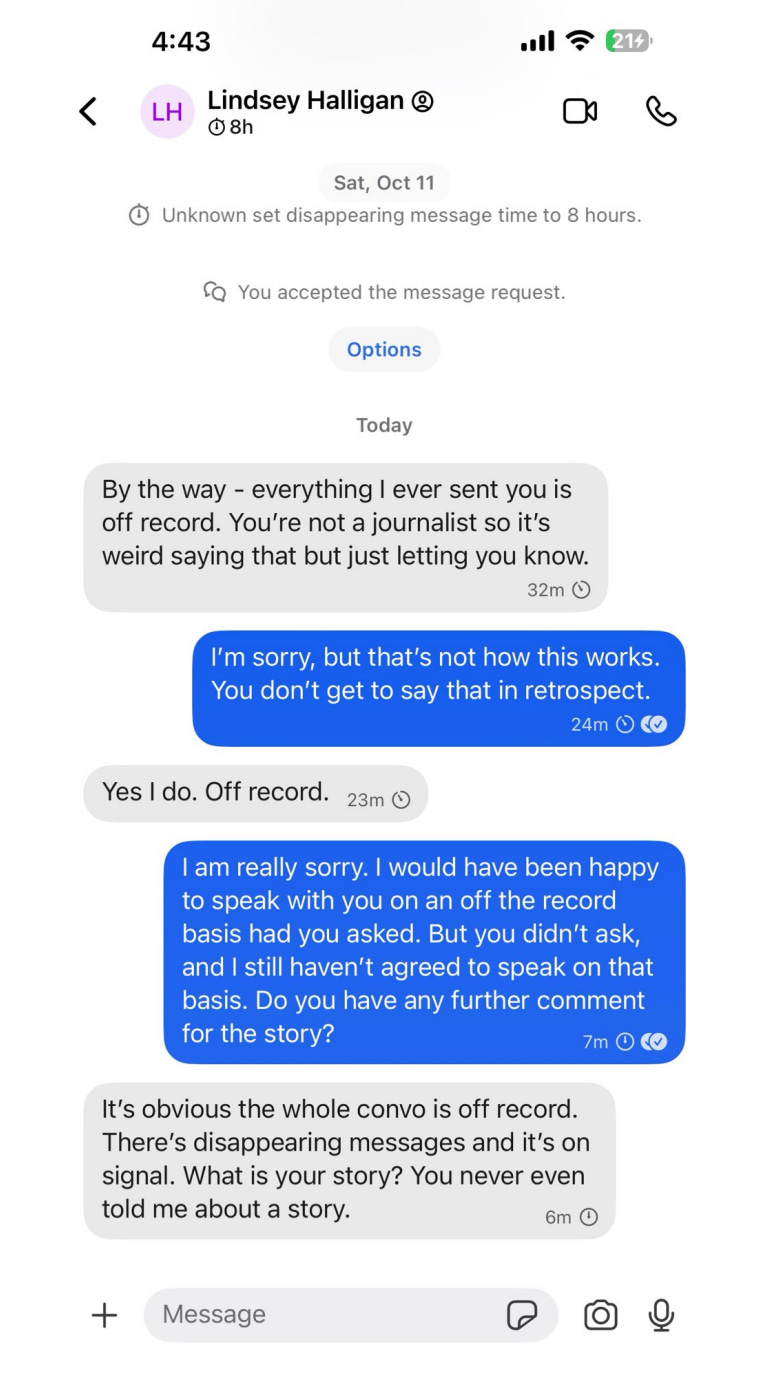
Then, after sniping at a reporter for documenting her conversation, Halligan went back to prosecuting a former government official for lying about conversations with reporters.
Maybe she’s just pissed because Jim Comey knows how to speak on background?
But Halligan, who never prosecuted a case in her life before Trump made her US Attorney for the Eastern District of Virginia, was just getting started.
Indictment mad libs
As we detailed last week, Halligan was appointed US Attorney in EDVA, one of the busiest dockets in the world, for the express purpose of indicting Trump’s enemies, New York Attorney General Letitia James and former FBI Director James Comey.
Having secured those indictments, she now finds herself attempting to prosecute two high profile cases on the “rocket docket,” with a compressed briefing schedule and a culture that prides itself on moving cases through faster than any federal district in the country.
It’s not going well.
On Monday, Comey’s team filed two aggressive motions to dismiss: one alleging selective and vindictive prosecution, and one alleging that Halligan was unlawfully appointed. Both contained revelations that could be fatal to the case.
Attached to the selective and vindictive motion was a 59-page spreadsheet cataloging all the nasty things Trump said about Comey since 2017, offered as evidence that this prosecution is the result of animus, rather than Comey’s alleged “crimes.” But that’s no revelation to anyone who’s logged onto social media in the past eight years. The revelation is that “PERSON 3” in the indictment is Comey’s lawyer and personal friend Daniel Richman, rather than former FBI deputy director Andrew McCabe.
The charging language was ambiguous — likely on purpose — and could support two different theories of the case.
Many people assumed that PERSON 3 must be McCabe, who was investigated back in 2019 for speaking to reporters (off the record) and claimed that Comey either authorized or blessed the media briefing post facto. McCabe was never charged, likely because the grand jury stiff-armed the government and refused to return an indictment, and he recently told CNN that he hadn’t spoken to prosecutors about this case.
That suggested that that PERSON 3 was Richman, a professor at Columbia Law School, who spoke to the New York Times about memos Comey drafted in 2017 documenting Trump’s effort to get him to kill the Russia investigation. According to ABC, Richman was subpoenaed by prosecutors in EDVA in September, and repeated his earlier public statements that Comey told him not to speak to the press.
Comey’s motion confirms that PERSON 3 is Richman, something the government only revealed to the defense two weeks after the case was filed. But that makes zero sense in the context of the September 30, 2020, hearing where Comey allegedly lied to Congress.
During that hearing, Sen. Ted Cruz asked Comey about prior testimony in 2017 when he denied authorizing “someone else at the FBI to be an anonymous source in news reports about the Trump investigation or the Clinton administration.” (Note that Halligan converted “Clinton administration” into "PERSON 1,” in yet another sleight of hand.)
“As you know, Mr. McCabe, who worked for you, has publicly and repeatedly stated that he leaked information to the Wall Street Journal and that you were directly aware of it and that you directly authorized it,” Cruz jabbed. “Now, what Mr. McCabe is saying and what you testified to this committee cannot both be true. One or the other is false. Who’s telling the truth?”
“I can only speak to my testimony. I stand by the testimony you summarized that I gave in May of 2017,” Comey responded.
As Comey pointed out in his motion to dismiss, the query was clearly about McCabe, and it’s a gross mischaracterization to claim that Comey lied about his discussions with Richman in this exchange.
She doesn’t even go here
The second revelation came in the motion to dismiss based on Halligan’s unlawful appointment as US Attorney for EDVA.
While Trump was pellucidly clear about why he pushed out her predecessor Erik Siebert, he’s been decidedly cagey about the legal authorization for her installation. That’s likely because his administration is on a losing streak in court as they attempt to shoehorn in US attorneys without Senate confirmation as required by the Constitution.
Two statutes lay out procedures for filling vacant positions where a permanent appointee must be confirmed by the Senate. The first is the Federal Vacancies Reform Act (FVRA), a rule of general applicability which promotes the first assistant to “acting” official for a maximum of 210 days in cases where the position becomes vacant. Alternatively, the president may appoint either an official who was Senate-confirmed to some other office, or a senior official in the agency where the vacancy occurred.
The second law, 28 USC § 546, allows the president to appoint an interim US Attorney for 120 days, after which the judges in that district are allowed to choose a successor. Often those judges tap the interim appointee, as they did in EDVA when Erik Seibert’s 120-day appointment expired and the judges gave him the nod to stay on. But in the District of New Jersey, the judges refused to bless the continued tenure of Alina Habba, another of Trump’s personal lawyers with no prosecutorial experience nominated to lead a US attorney’s office.
This snub incensed Attorney General Pam Bondi, who employed a series of maneuvers to keep Habba on the job. She made Habba the first assistant, counting on the FVRA to buy her another 210 days in office. And then she appointed Habba special counsel under the same law that Merrick Garland used to appoint Jack Smith to investigate Trump.
Bondi repeated this play at least twice with other interim appointees who timed out, including in the District of Nevada and in Los Angeles, where she seems to be suggesting that MAGA lawyer Bill Essayli is serving simultaneously as the acting US attorney and his own first assistant. All three appointments drew challenges from criminal defendants arguing that their prosecutions are invalid because the US attorney in charge was illegally installed.
And while the Essayli case is still percolating, courts in Nevada and New Jersey both concluded that Trump cannot make an end run around Senate confirmation by dint of these shenanigans. The president gets one 120-day interim appointment under § 546, and he can’t use the FVRA as ONE WEIRD TRICK to squeeze out another 210 days. In fact, the Third Circuit heard the appeal of Habba’s disqualification on Monday, and the panel seemed entirely inclined to agree with the trial judge that she’s not serving legally.
And so it was very odd to see the appointment order for Halligan attached to Comey’s motion to dismiss on Monday.
Bondi relied solely on § 546? After two courts had already ruled that the president gets just one interim appointment, which he already used up on Erik Seibert? She didn’t even try to squeeze Halligan in under the FVRA?
MA’AM.
In New Jersey and Nevada, the criminal defendants who challenged Habba and Chattah’s appointments failed to get their cases dismissed, since multiple other lawyers participated in the prosecutions. Here, no other lawyer at EDVA would get near the Comey indictment, which Siebert, a career prosecutor, rejected after a thorough investigation.
Halligan herself presented the case to the grand jury, and Halligan’s name is the only one on the signature line. As Comey pointed out in his motion to dismiss, “Ms. Halligan’s unlawful appointment renders her purported official actions void ab initio. The indictment against Mr. Comey that she alone secured and signed is thus a nullity and should be dismissed.“ And that probably goes for the indictment of Tish James, too, since it was also a Halligan-only joint.
But wait, there’s more!
Halligan’s humiliation wasn’t over, though, as her office filed a motion to expedite the court’s ruling on a filter protocol to deal with information seized from a lawyer in a prior investigation — presumably from Daniel Richman when the DOJ tried to get Comey for lying the last time Trump was in office.
The entire cache will have to be sorted to allow Comey to weed out documents protected by attorney-client privilege, and the prosecutors proposed procedures for the process a week ago. Comey had two weeks to respond, but Halligan’s team essentially asked Judge Michael Nachmanoff to greenlight their plan without giving Comey a chance to weigh in.
This was wildly out of order, but it wasn’t even the most squirrelly thing about the motion. Halligan suggested that haste was required because some of the communications seized from Richman implicate Pat Fitzgerald, Comey’s lawyer, who also represented him in 2017. How the one follows the other was not explained, but then Halligan suggested that “based on publicly disclosed information, the defendant used current lead defense counsel to improperly disclose classified information.”
That is an outrageous lie. The Inspector General’s report on the earlier Comey investigation “found no evidence that Comey or his attorneys released any of the classified information contained in any of the Memos to the media.”
Comey’s team hit the roof, denouncing the government’s “unlawful” pawing through Richman’s hard drive and denouncing “the government’s effort to defame lead defense counsel.”
Judge Nachmanoff was also unimpressed. He denied the motion and called out Team Halligan’s inappropriate suggestions about Fitzgerald:
To the extent the government expresses concern about adhering to the schedule set by the Court at arraignment, the Court notes that the government has had the materials at issue in its possession for several years and apparently failed to seek any guidance with respect to a filter protocol at any time before October 13, 2025. Moreover, the government was fully aware of Mr. Fitzgerald’s participation in this case as early as September 25, 2025, and the report that forms the basis of the claim that “[D]efendant used lead defense counsel to improperly disclose classified information” has been public knowledge since its 2019 publication. And yet, the government failed to raise any concern with lead counsel’s representation until the filing of the government’s motion to expedite on October 19, 2025.
It seems fairly unlikely that further efforts to disqualify Fitzgerald will succeed. Halligan will just have to go to trial against the former US attorney for Illinois, who served as special counsel and headed up the Organized Crime-Terrorism Unit at the Southern District of New York. Unless Judge Nachmanoff puts this ridiculous case out of its misery before then, which seems increasingly likely in light of Monday’s revelations.
That’s it for today
We’ll be back with more tomorrow. If you appreciate today’s PN, please do your part to keep us free by signing up for a paid subscription.
Thanks for reading, and for your support.


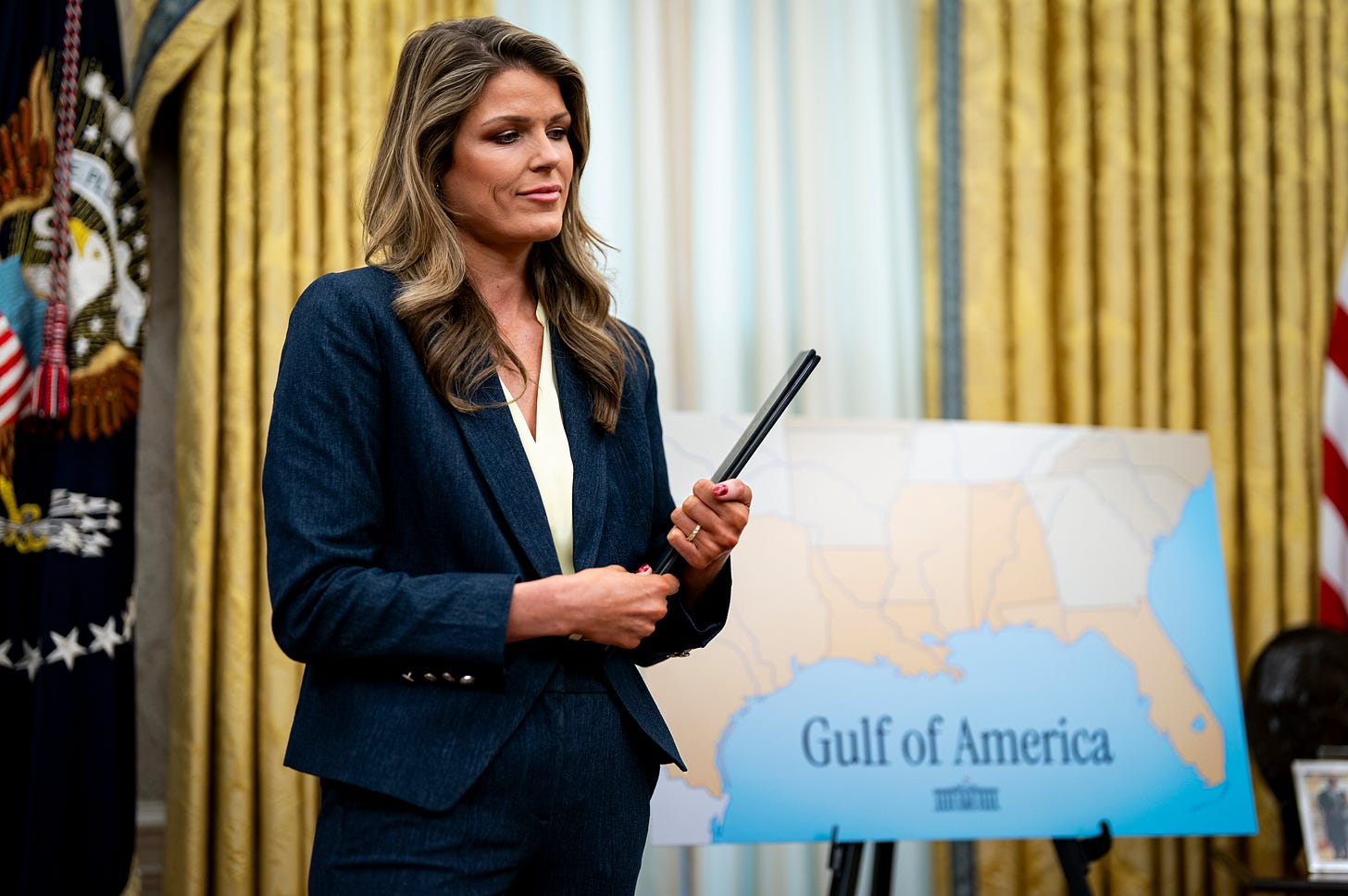
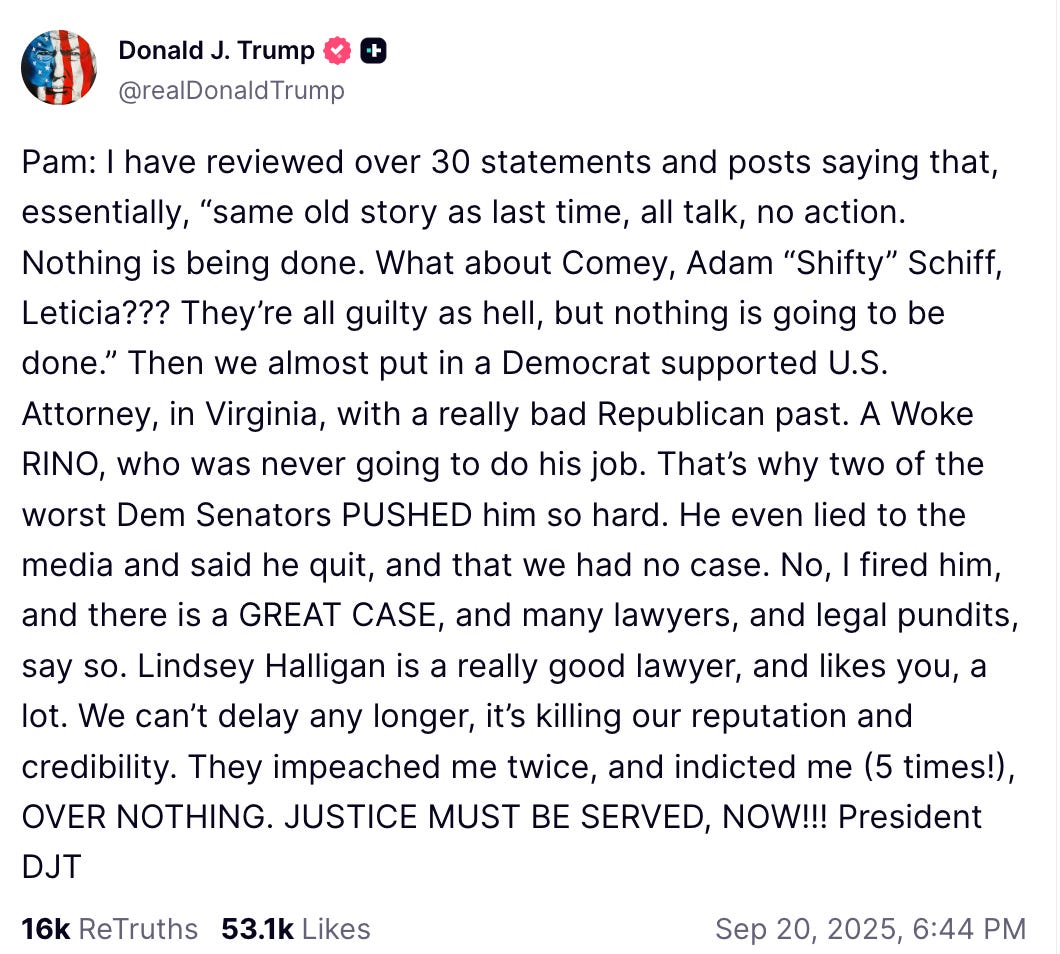

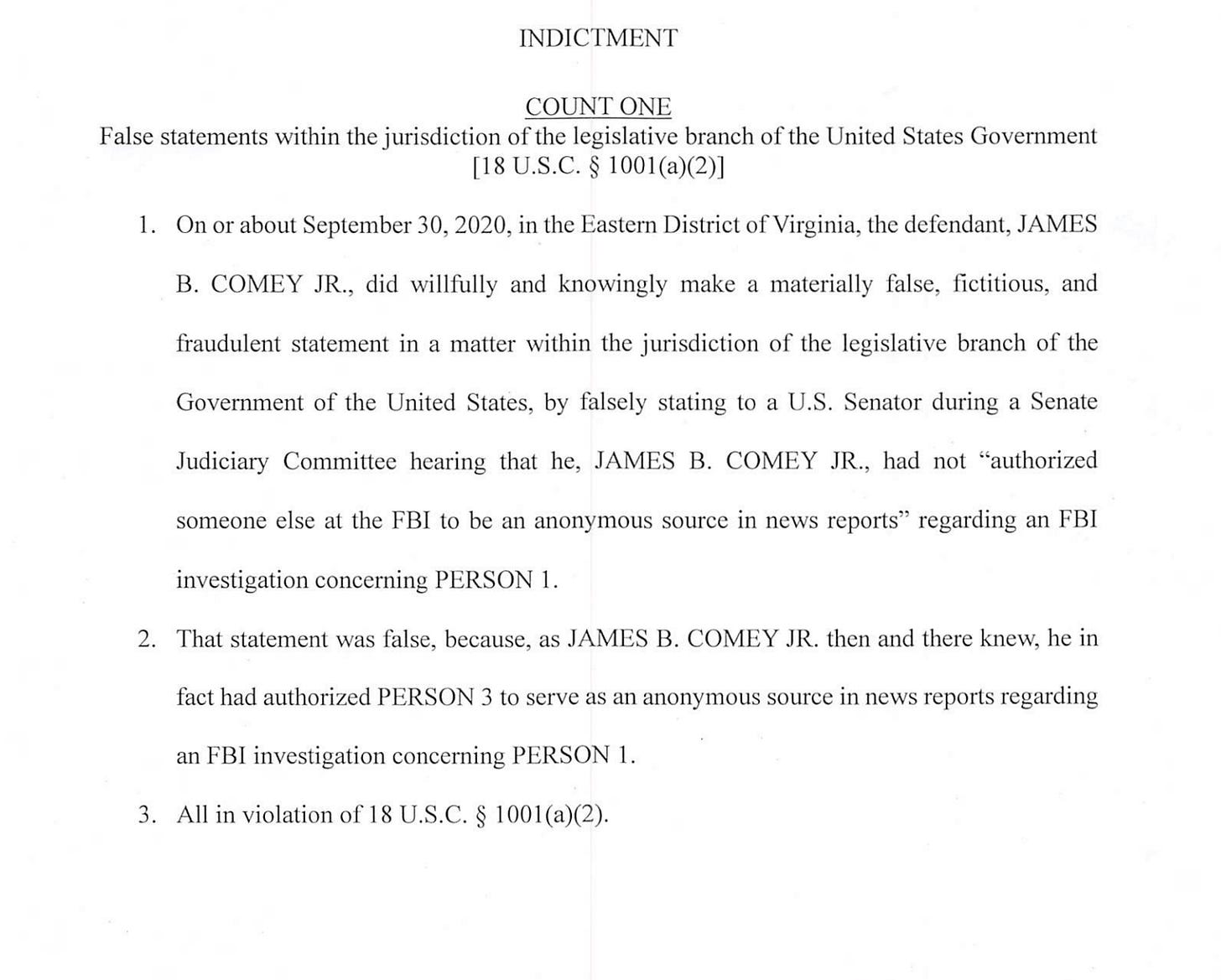

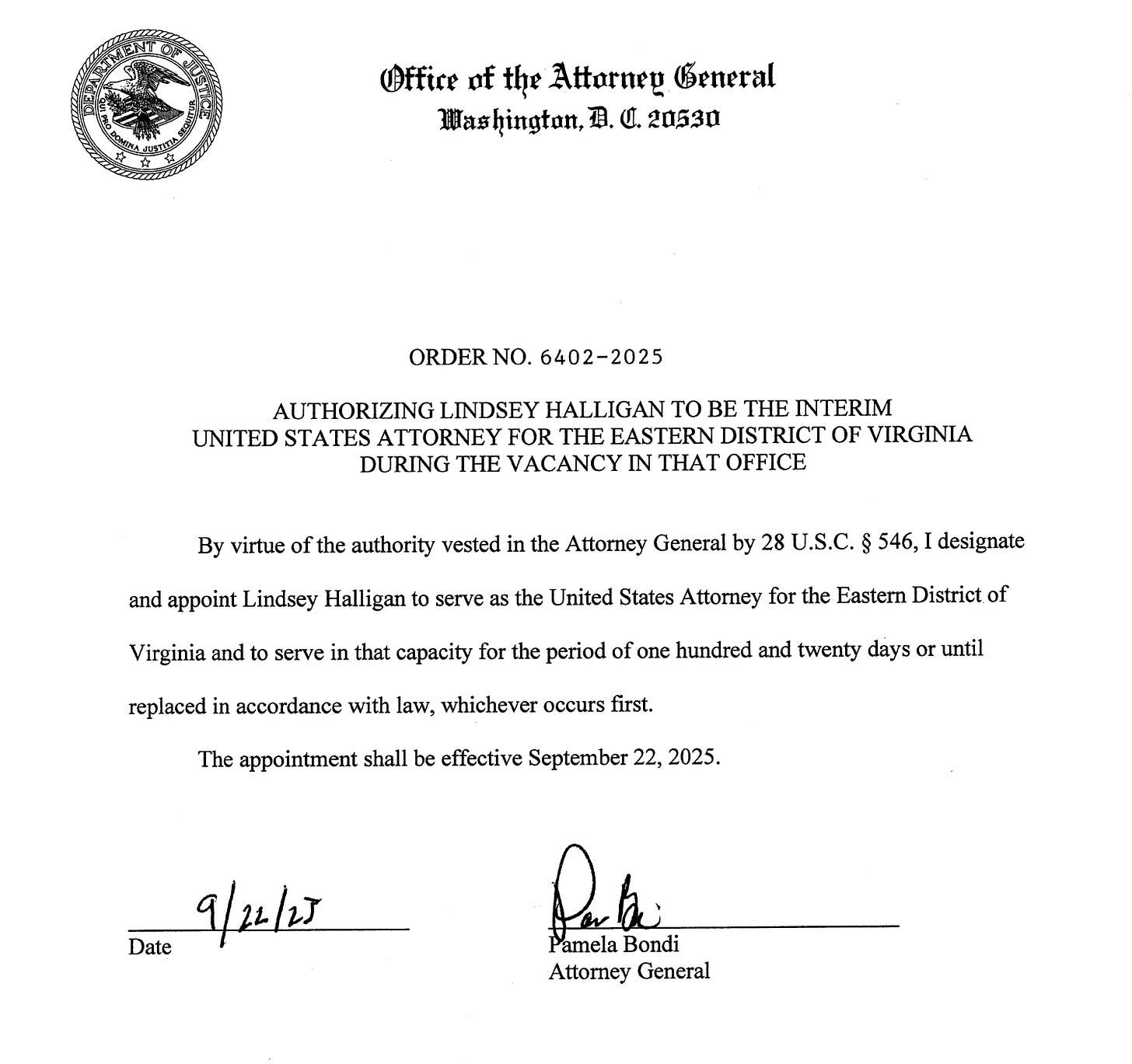
From bungling basic media norms to filing a motion that tried to skip due process and smear defense counsel, the spectacle reveals a system that confuses aggression with strategy.
When governance becomes performance, legal institutions don’t just lose credibility, they lose behavioral coherence.
This whole thing feels like a spoof.
If this case weren’t so serious in regards to Trump’s retribution plans it would be laughable. I look forward to seeing his (and Bondi’s) very unqualified attorney fall on her face in full view as the rest of the country views exactly how low the DOJ has fallen under his administration.